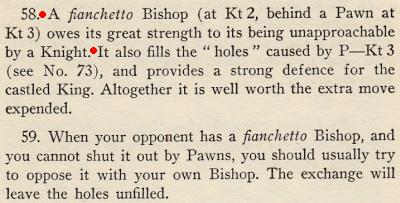
Edward Winter
Neil McDonald (Gravesend, England) asks:
‘When did the word “fianchetto” first come into popular usage (as opposed to being coined)?’
Outside of Italy, at least, we wonder whether ‘fianchetto’ was widely understood by chessplayers until the second quarter of the nineteenth century, by which time games featuring the manoeuvre were by no means uncommon.
The first two volumes of the Chess Player’s Chronicle (1841 and 1842 – pages 49-51 and 182-183 respectively) had games which began 1 g3, although ‘fianchetto’ did not appear. However, the fianchetto was often regarded as an eccentricity, and on page 28 of The Art of Chess-Play: A New Treatise on the Game of Chess (London, 1846) George Walker wrote:
‘Some players always begin the game by moving their knights’ pawns one square, and then playing the bishops on to the knights’ second squares. Avoid this, as productive of a crowded situation.’
‘On the Fianchetto’ was a sub-heading in a section entitled ‘On Several Incorrect Openings’ on page 36 of Jaenisch’s Chess Preceptor by C.F. de Jaenisch and translated by Walker (London, 1847). After 1 e4 b6 the following comment was given:
‘It is, in general, dangerous to advance the knights’ pawns one before the close of the game; for the wings become necessarily weakened, and castling is thereby rendered dangerous. Moreover, two squares are opened to attack, which the bishops cannot always continue to defend by occupying the intervals, as surely as even the pawns themselves. The move 1...b6 is less to be condemned than 1...g6 because it is on queen’s flank; and because the bishop placed on b7 batters the adverse royal wing; while the move 1...g6 weakens the royal flank; and only yields KB an attacking range upon adverse queen’s side.’
Pages 379-380 of Staunton’s The Chess-Player’s Handbook (London, 1847) had a game headed ‘The Fianchetto’, with this note after 1 e4 b6:
‘Black’s present move, which the Italians call “Il Fianchetto di Donna”, although disapproved of by the earlier writers, may be made by the second player without harm, if followed speedily by ...e6 and ...c5. It is not, however, so advisable a mode of opening the game for the first player as the more customary moves, from its being essentially defensive.’
Around this time, ‘fianchetto’ was usually a reference to 1 e4 b6. For instance, on page 298 of the October 1858 Chess Monthly this definition was given:
‘Fianchetto, Sub. The title of an opening formed by 1 e4 b6. It is derived from the Italian Fianco, flank, and the diminutive termination etto.’
The section headed ‘The Fianchetto’ on page 266 of The Chess Openings by Robert B. Wormald (London, 1875) also concerned only 1 e4 b6. Later openings books gradually used ‘fianchetto’ more broadly, one example being Chess Openings Ancient and Modern by E. Freeborough and C.E. Ranken, various editions of which had ‘King’s Fianchetto’ for 1 g3 and ‘Queen’s Fianchetto’ for 1 b3, as well as ‘The Fianchetto Defence’ for 1 e4 b6 and 1 e4 g6. Some later volumes retained the Italian terms ‘Fianchetto di Donna’ and ‘Fianchetto di Re’; see, for example, page 3 of the fifth edition of The Chess Players’ Compendium by William Cook (Philadelphia, 1910).
The above are, of course, merely jottings on how usage of ‘fianchetto’ evolved in English-language sources, and we shall be grateful for further relevant citations.
On page 344 of the August 1927 BCM the following game annotation appeared after 1 e4 e6 2 g3: ‘“Everything gets fianchettised nowadays”, wrote Dr Tartakower a few years ago.’ Where did that observation first appear?
(4556)
From Chess in 1924:
At all levels of the chess world it was proving a struggle to come to terms with the newfangled openings. The game Torre v Jennings, New York, 1924 began 1 d4 Nf6 2 Nf3 g6 3 Nc3 b6 4 e4 Bb7 5 Bd3 Bg7, prompting C.S. Howell to remark (American Chess Bulletin, December 1924, page 217): ‘Chess rules need revision, indeed, if Black must resort to the double “fianshutyourpiecesin” defense.’
Examples of chess instruction which have an original or unusual slant are always welcome.
Page 16 of One Hundred Chess Maxims by C.D. Locock (Leeds, 1930) stated:
‘A fianchetto bishop (at Kt2, behind a pawn at Kt3) owes its great strength to its being unapproachable by a knight.’

(8720)
The text of C.N. 71 (‘The leisurely fianchetto’):
What is the longest gap in master play between a g- or b- pawn being advanced and the subsequent placing of a bishop on one of the ‘knight two’ squares?
In C.N. 98 W.H. Cozens (Ilminster, England) remarked on the comparative merits of the descriptive and algebraic notations in such an instance:
1. (Descriptive): What is the longest gap in master play between P-Kt3 and the subsequent B-Kt2?
2. (Algebraic): What is the longest gap in master play between the playing of b3, b6, g3 or g6 and the subsequent Bb2, Bb7, Bg2 or Bg7, as the case may be?
Mr Cozens concluded:
‘Algebraic, for some purposes, can be downright silly.’
(9650)
A similar example of a text not easily expressed in the algebraic notation is on page 25 of Fischer/Spassky by Richard Roberts, with Harold C. Schonberg, Al Horowitz and Samuel Reshevsky (New York, 1972):
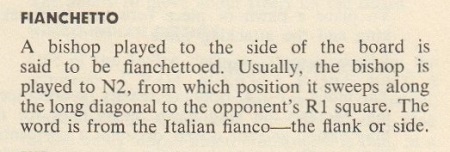
Bill Margolis (Laguna Woods, CA, USA) raises the subject of the English pronunciation of ‘fianchetto’.
We note that although a number of beginners’ books state that the word should be pronounced all’italiana (a rough guide such as ‘fyan-ketto’ being offered), English dictionaries tend to disagree. For example, the on-line Oxford English Dictionary has this:
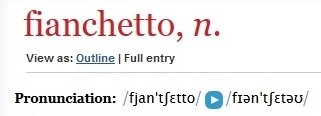
From page 602 of the Collins Dictionary (Glasgow, 2007):

Not all definitions include a bishop’s development to R3. The on-line Oxford English Dictionary states:
‘The development of a bishop by moving it one square to a long diagonal of the board.’
Another example:
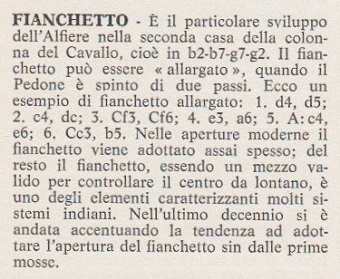
Source: page 218 of the Dizionario enciclopedico degli scacchi by A. Chicco and G. Porreca (Milan, 1971). Chicco is pronounced similarly to ‘kee-ko’ ...
(9820)
A favourite book of ours is Chess Combination as a Fine Art, a work by Paul Keres and Werner Golz based on the writings of Kurt Richter. The English edition came from Pitman in 1976. On page 19 the following position is given from the game Vanka v Skala, Prague, 1960:
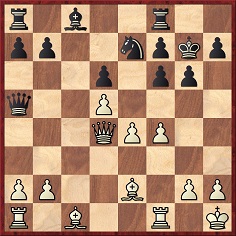
Play went 1 b4 Qd8 2 Qxf6+ Kxf6 3 Bb2 mate. ‘Have you ever achieved mate by a fianchetto movement with the bishop?’
(58)
Earliest Occurrences of Chess Terms has this citations:
OED: ‘Black’s present move, which the Italians call “Il Fianchetto di Donna” ...’ The Chess-Player’s Handbook by H. Staunton (London, 1847), page 379.
The OED incorrectly gives 1848.
From page 422 of the October 2024 BCM:
‘Signor A. Dolci, whom Yorkshire chessplayers will remember, recently played a series of friendly matches in Genoa with Col. Stuart Prince, formerly of Nairobi, whose acquaintance we had the pleasure of making at Southport in August. Signor Dolci exploited with some success his own “Genoese Defence”, which consists in the following six moves for Black:
1 (P-Q4) P-K3 2 (P-QB4) P-KKt3 3 (Kt-QB3) B-Kt2 4 B-B4 P-Kt3 (5 P-K3 or 4) B-Kt2 6 (Kt-B3) Kt-K2.
This “Double Fianchetto” for Black, however, is no novelty.’
1 d4 e6 2 c4 g6 3 Nc3 Bg7 4 Bf4 b6 5 e3 or e4 Bb7 6 Nf3 Ne7.
To the Chess Notes main page.
To the Archives for other feature articles.
Copyright: Edward Winter. All rights reserved.